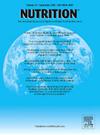Water turnover estimated by prediction equation and all-cause and cause-specific mortality in Japan: A cross-sectional prefecture-level ecological study
IF 3.2
3区 医学
Q2 NUTRITION & DIETETICS
引用次数: 0
Abstract
Objective
Although water is essential for maintaining life and health, the association of water turnover (WT) with mortality is, to our knowledge, unknown. We aimed to 1) determine the annual mean and variance of WT and 2) evaluate the association between WT and mortality in all 47 prefectures in Japan.
Methods
This cross-sectional, prefecture-level ecological study used data from government surveys that provided prefecture-level data. WT was calculated considering lifestyle and environmental factors using an equation previously developed by the international doubly labeled water database group. Each prefecture was classified into a WT quartile. We obtained data on age-standardized mortality from the 2015 Vital Statistics. The mortality rate ratio (RR) was calculated using a multivariable Poisson regression model.
Results
The annual mean and variance of WT were 3771 and 990 mL/d in men and 3084 and 990 mL/d in women, respectively. After adjusting for confounders, compared to the prefecture in the highest WT quartile, those in the lowest WT quartile were associated with a higher mortality RR for all-cause (Men: RR = 1.07 [95% confidence interval (CI) = 1.02–1.11]; Women: RR = 1.05 [95% CI = 1.00–1.11]) and stroke (Men: RR = 1.16 [95% CI = 1.00–1.33]; Women: RR = 1.18 [95% CI = 1.01–1.42]). This association was moderately weaker when adjusted for exercise habits, especially among women.
Conclusions
Our findings indicate large regional and seasonal variations in WT in Japan and that the risk of excess death due to lower WT may be partially explained by physical activity.
求助全文
约1分钟内获得全文
求助全文
来源期刊

Nutrition
医学-营养学
CiteScore
7.80
自引率
2.30%
发文量
300
审稿时长
60 days
期刊介绍:
Nutrition has an open access mirror journal Nutrition: X, sharing the same aims and scope, editorial team, submission system and rigorous peer review.
Founded by Michael M. Meguid in the early 1980''s, Nutrition presents advances in nutrition research and science, informs its readers on new and advancing technologies and data in clinical nutrition practice, encourages the application of outcomes research and meta-analyses to problems in patient-related nutrition; and seeks to help clarify and set the research, policy and practice agenda for nutrition science to enhance human well-being in the years ahead.
 求助内容:
求助内容: 应助结果提醒方式:
应助结果提醒方式:


